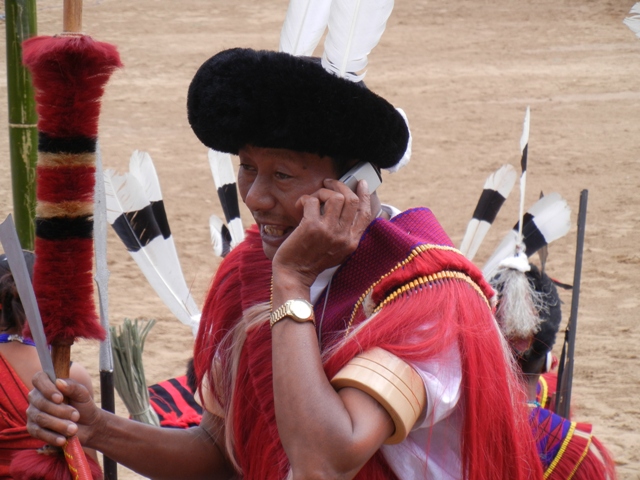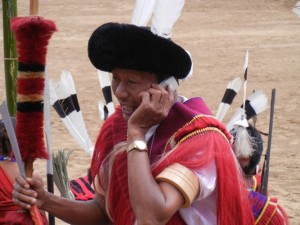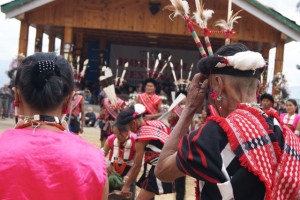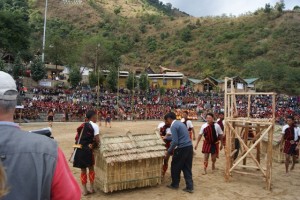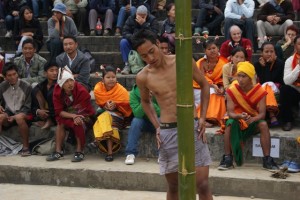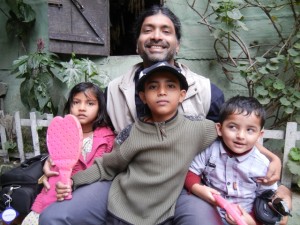(This update is from day three of Hornbill Festival. Dear reader, apologies for the delay in the update as businesses take a strict break in Christian-dominated Nagaland.)
Petering out crowd is a challenge to any festival. Keeping the audience interest alive is a comment on the organisers’ ingenuity and imagination. Day three of the Hornbill was hence a test; the teasers had done their job, the flitters had left and the real festival junkies slouched around to check whether the varnish peeled. With the honeymoon over and the real business of the festival settling in, the best way out was to rekindle the passion for storytelling so prevalent in the Naga culture. The Pangan of the Chang tribe was a slomo dance with vigorous vocals to herald in the winter season. Tapping two conical hard leather instruments, the sound which would awaken the souls of the forefathers – to ensure victory in warfare, the Phoms took the arena with their ‘Blowing Horns’ ritual. The Bhandari Osho Sharu sounded very much like a church choir. Sung only on occasions by the Lothas, it celebrated the commemoration of the best warrior in the clan by the chief who would drape him in a shawl called the Longbensu. My personal favourite was the Akhu Keteli of the Rengmas. Here the young tribe members would visit the houses of newly married couples and dance outside singing, demanding the wife’s price from the groom – to be paid in meat or beer. I remembered a similar occasion when a bunch of tykes threatened not to leave my bedroom unless I paid up. The ritual purification dance of the Chakhesangs helped them keep their resolutions for the New Year; something like the Christian confession. Whether you wielded the dao or wore denim, these were striking pointers to a common genesis. The action outside the ring was equally evocative. The tribal lads with their ripped torsos, humungous calves and devil-may-care attitudes were a huge draw for everyone, especially the visiting women. Any photographer or cameraman coming in the view of their eye candies was shredded to bits. Understandably many found this to be a bit overwrought and there were quite a few verbal scuffles. “The behaviour of some Western photographers was indeed embarrassing,” said Dominique Rowe, a writer from New Zealand. “However, the balancing act was that the guys themselves went overboard wanting to take photographs with them.” Dominique must know as she got three photograph requests from local dandies as she was speaking to me.“These guys are really nice people,” said Piran Elavia by means of an explanation. “They wear their heart on their sleeves.” I could second that. Piran went on to elaborate that the culture of the state permitted them to be open about appreciating beauty; taking photographs with a stranger girl was their way of telling her that her beauty was acknowledged. An eco-tourism activist, his organisation Kipepeo (butterfly in Swahili) promotes tourism to the north east. Day three also saw the start of many inter-tribe competitions. The greased bamboo pole climbing didn’t see any winner despite close to an hour of wriggling up and slithering down. The organisers had to take down the poles and rub off most of the glistening fat with ragged jute. Whistles blown again and the fastest to reach the top was adjudged winner. Well, rules are written to be rewritten. Over the next few days there was going to be pork and chilly eating competitions. Zhavi, whose wife is a nurse, told me that doctors would be kept on high alert during these two, the latter, especially.
I can’t wait.


